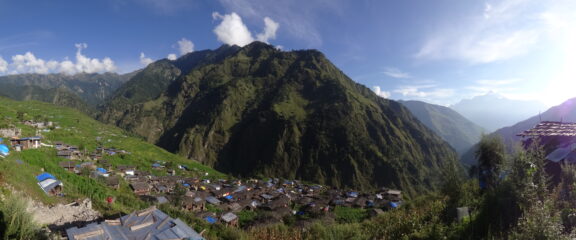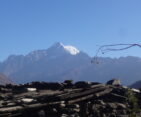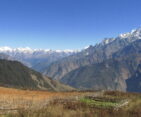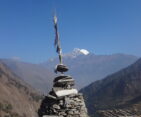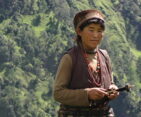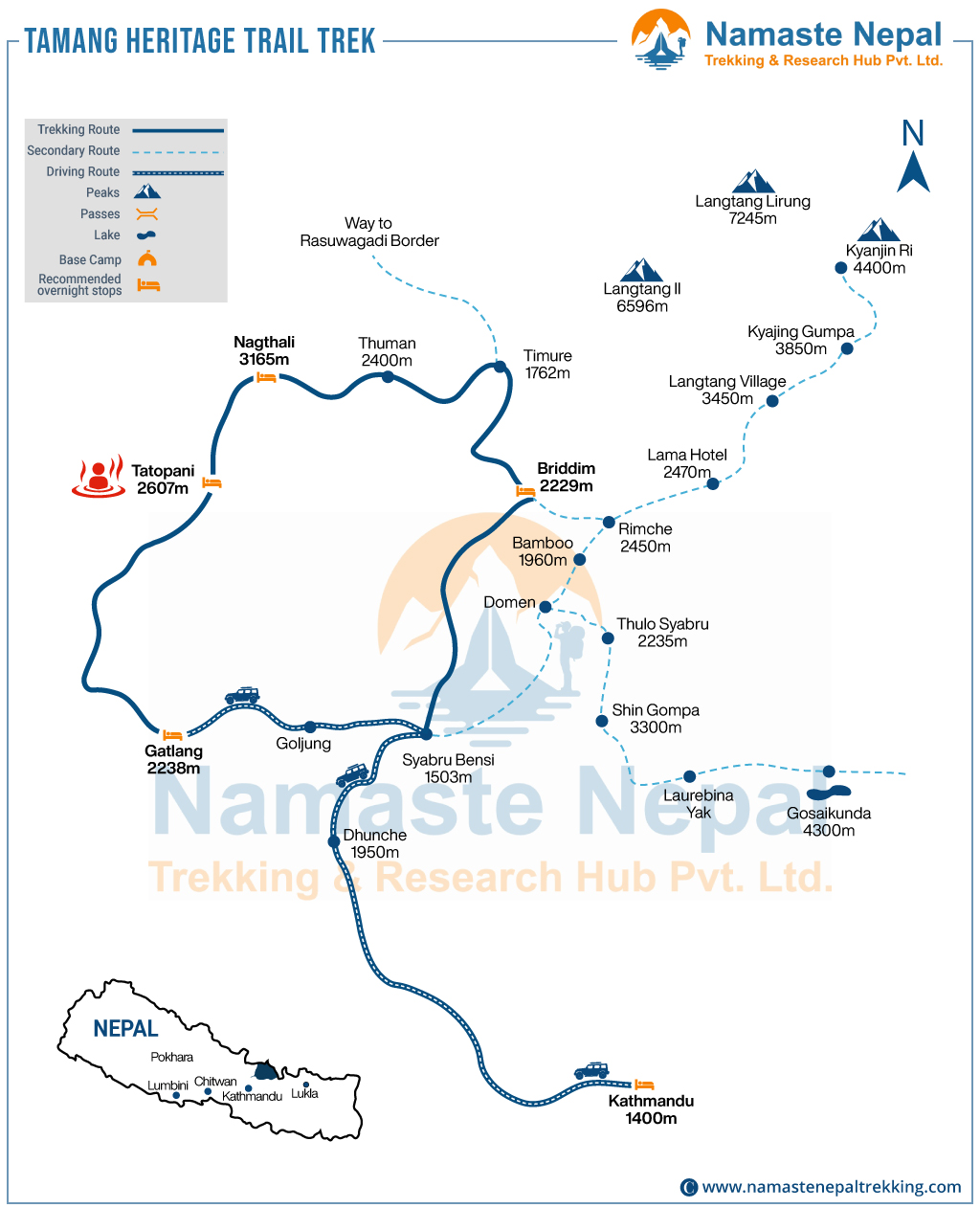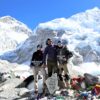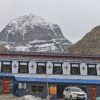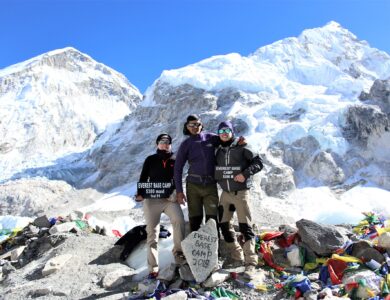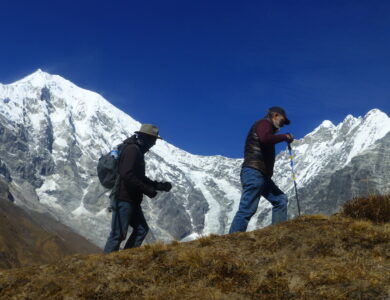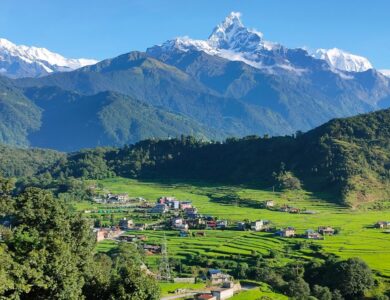Tamang Heritage Trail Trek - 9 Days
09 Days
Easy
3650
1-20 People
Kathmandu
Spring , Autumn and Early Winter
- 7 Breakfast
- 7 Lunch
- 6 Dinner
- 3-Star Hotel in Kathmandu
- Best Available Guesthouse
- Private Tourist Vehicle
- Super Express Local Bus
- 1 - 1 personUS$ 885
- 2 - 2 personUS$ 750
- 3 - 5 personUS$ 695
- 6 - 10 personUS$ 650
- 11 over 9999 US$ 600
- Your safety, our no 1 priority
- Best price guarantee
- Experienced & dedicated team
- Easy booking, no hidden charge
- You can customize this trip
US$ 885
Highlights of Tamang Heritage Trail
- Experience a cultural trek in which you can learn about one of Nepal’s Tibetan-influenced hill tribes, and directly contribute to their rural economy
- Explore around Gatlang (The Black Village), Get to know what our Charity doing to Change the Lifestyle of Locals
- Stay in a local homestay in Briddim, to learn more about the Tamang people and their way of life
- Enjoy spectacular views of Ganesh Himal, the Langtang Himalayas, and the Gosainkund range
Trip Overview
Venture into an adventure that guarantees awe, discovery, and togetherness with the Tamang Heritage Trail, a great family-friendly adventure nestled within the heart of Nepal. From breathtaking mountain vistas to wealthy cultural exchanges, this trek gives an unforgettable experience that leaves lasting memories for the entire family.
Breathtaking landscapes
The Tamang Heritage Trail opens out against the majestic setting of Nepal’s Langtang region. Hiking through lush valleys, dense forests, and rugged mountains, you will marvel at iconic peaks like Langtang Lirung, Ganesh Himal, and Dorje Lakpa, lofting proudly against the azure sky. Along the trail, stunning waterfalls cascade down sheer cliffs, while peaceful alpine lakes sparkle in the sunlight, reflecting the surrounding snowcapped peaks. Passes through rhododendron-filled forest, flaming with vibrant color, and climbs up to high-altitude pastures, yaks grazing peacefully, admiring the breathtaking scenery. Offers a feast for the senses at every turn.
Cultural experience
Dig into the vibrant culture and traditions of the Tamang people on the Tamang Heritage Trail, where cultural immersion takes center stage. As you trek through the Himalayan foothills, you will encounter traditional Tamang villages sheer in age-old customs and rituals. Participate with the welcoming locals, be a part of cultural ceremonies, and collect treasured insights into the daily lives of the Tamang community. Experience the warmth of Nepalese hospitality as you live in real homestays, savoring scrumptious Tamang delicacies prepared with love and care. Immerse yourself in the wealthy tapestry of Tamang culture, witnessing colorful fairs that honor the area’s unique history and identity. The Tamang Heritage Trail offers an unparalleled opportunity for cultural exchange, stimulating meaningful connections and intensifying your appreciation for the diverse traditions of Nepal’s mountain communities.
Family-friendly challenges
Designed with families in mind, the Tamang Heritage Trail capabilities attainable trails that might be appropriate for trekkers of every age. The mild climbs and scenic routes ensure a feeling of journey without being overwhelmed. Children and adults alike will experience the bodily challenges, fostering a sense of success and bonding. Along the way, herbal warm springs provide the best spots for relaxation, permitting your own family to rejuvenate within the midst of serene landscapes.
Educational and enriching
This trek is not simply a journey but additionally an academic revel in. Your own family will study the flowers and fauna of the vicinity, the history and traditions of the Tamang communities, and the geography of the Himalayas. These lessons, discovered inside the context of an thrilling adventure, are both enriching and memorable.
The unique combination of stunning herbal beauty, immersive cultural reviews, and its own family-friendly, physically demanding situations makes the Tamang Heritage Trail a remarkable adventure. This journey guarantees no longer best first-rate, once-in-a-lifetime reminiscences, but also a deeper reference to each other and the essence of Nepal. For families looking for a special and bonding experience, the Tamang Heritage Trail will be an excellent family-friendly hiking vacation spot in Nepal.
What to Assume in the Tamang Heritage Trail?
- Trail: The trek unfolds alongside clear-cut trails that wind through the picturesque landscapes of the Langtang region. Expect a combination of mild conquest, moderate climbs, and irregular steep sections, presenting a balanced project for trekkers of various talents. You will bypass lush forests, vibrant villages, and serene valleys, with awe-inspiring mountain vistas at each turn.
- Accommodation: Accommodation alongside the Tamang Heritage Trail spans from comfortable teahouses to true homestays, providing a possibility to immerse yourself in nearby hospitality. Teahouses provide easy yet comfortable lodging with simple amenities, at the same time as homestays provide an extra immersive cultural enjoy, permitting you to stay alongside Tamang families and participate in their day-to-day activities.
- Local Cuisine: Get pleasure from the flavors of traditional Tamang cuisine as you hike through the place. Expect delicacy of Nepalese and Tibetan delicacies offering locally sourced substances including rice, lentils, greens, and yak meat. Don’t pass over the opportunity to sample nearby meals like dal Bhat (rice and lentil soup), momos (dumplings), and thukpa (noodle soup), providing nourishment and warmth after a day on the path.
- Notable Landmarks: Along the way, you may come across numerous excellent landmarks that provide insight into the area’s cultural and historical background. Visit historical monasteries, inclusive of the Tamang Gompa in Briddim, where you can notice Buddhist rituals and appreciate intricate artwork. Explore the secure village of Gatlang, regarded for its exceptional stone houses and terraced fields. Marvel at the breathtaking perspectives from viewpoints like Nagthali and Goljung Pass, which offer panoramic vistas of the surrounding mountains and valleys.
- Tamang Culture and Heritage Sites: Explore ancient monasteries, chortens (Buddhist stupas), and Tamang cultural facilities scattered throughout the area. These websites provide insight into the wealthy spiritual and cultural background of the Tamang people, with intricately carved prayer wheels, colorful prayer flags, and ornate Buddhist artwork.
- Warm Hospitality: The Tamang people are regarded for his or her warmth and hospitality, and you’ll enjoy this, in my opinion, as you live in neighborhood tea homes and homestays alongside the trekking course. Enjoy delicious homemade food organized with regionally sourced substances and share stories together with your hosts around the hearth in the evenings.
- Cultural Festivals and Events: Depending on the timing of your trek, you could have the hazard of witnessing conventional Tamang galas and events. These colorful celebrations frequently include track, dance, and religious rituals, presenting a charming glimpse into the Tamang subculture and spirituality.
In essence, the Tamang Heritage Trail is an excellent adventure that merges stunning surroundings, cultural immersion, and real reports, imparting a deeper understanding of the Tamang manner of life and the natural beauty of the Langtang region.
Tamang Heritage Trail: is this Trip Right for you?
Ultimately, the Tamang Heritage Trail is right for you according to circumstances and individual interest, fitness level, and willingness to embrace the challenges and rewards of trekking in the Himalayas.
Physical Demands of the Trek
Tourists who want to be involved in such a culturally enormous trek in a short period, with a tiny trekking background, love the Chandan Bates and viewing the electrifying settlement; this is the perfect choice for them. This trek takes you through twenty or more artistic recompenses and praised settlements such as Gatlang, Chilime, Thuman, Timure, and Bridim. After a beautiful and rewarding exploration of artistic society, changes can be observed from Gatlang to Thuman. Timure has Tibetan influence and is somewhere in the direction of Tibet.
Required Fitness Level
The Tamang Heritage Trail is a really perfect trek for those with a slight to a suitable degree of health. It isn’t always technically hard, but being at excessive altitudes can expect a swiftly changing climate, which could make the trail extra difficult. The first trek provides a good test of your present fitness and confidence levels. It is also better if you have a degree of stamina, good health, and adequate trekking experience.
Altitude Challenges
Tamang is an indigenous people from the Langtang region. Normally, Tamang people have no problems living at high altitudes. However, other ethnic groups from different parts of the country may face physical demands at high altitudes, even if they are accustomed to living in the Nepalese lowlands. There is no norm on how high altitude can affect individuals. People respond differently due to physical condition, sex, age, previous mountain experience, food habits, and genetic components. Trekkers who have never experienced altitude sickness are more at risk than other people. Generally, the most important causes of acute mountain sickness (AMS) are restlessness, irritability, and severe headaches, which are not relieved by medication and are caused by small superficial blood cells.
Mental Demand:
Based on the different experiences of local people, guides, and cooks, the Tamang Heritage Trail has a slight likelihood of creating mental disturbances in trekkers. The different phenomena during the Tamang Heritage Trek were seen to require mental resistance by some trekkers. Most of the trekkers faced difficulties during trekking, including the difficulty of the trail and continuously changing landscapes.
Cultural Adaptation and Language Barrier
Most of the Tamang people do not speak or understand the English language. However, some people know English, but it is very limited in this area. Most of the tourists have suffered and found difficulties in communicating their feelings and mood with the Tamang people. If it were in a foreign country, then it would be a different scenario. If you remember the dialogue from the movie named “There is no need to speak, only the heart should be joined and give the full offering” — it is also like that, such a kind of dialogue. We talk about body language; we talk about non-verbal communication — people understand each other well.
Cultural adaptation and trekking are the major interesting aspects for the tourists along the Tamang Heritage Trail. Everything is different except the mobile network. The cultures, lifestyles, dress, building styles, elevation, geography, food habits, and everything look different. Most of the tourists prefer trekking around the Langtang region, as Langtang offers the scenery of the surrounding mountains. Although Langtang Trek also offers a cultural part of the Tamang societies and Tibetan settlements of the region.
Mental strength and resilience
Mental strength and resilience. One of the most highlighted aspects of the Tamang Heritage Trail is its long walking trails that hike to an altitude of 3,100 m above sea level. Together with these, a brief study found that the walking trails in the area are steep and perilous. The walks that ever cross the hill ridge with deep and slippery jungle slopes, with five to six hours of daily walking and crossing rocky landslide areas, need extra attention to avoid injury.
Remote and Isolated Location The
Tamang Heritage Trail lies in a remote and isolated location, far from urban areas, making it difficult to travel to. The mud paths that are used for travel are not well managed and are not strong enough to resist soil erosion during the rainy season. In addition, during snowfall, the road can be blocked for days. The area lacks basic facilities such as health posts, education, transportation, and markets for daily necessities. Taplan, the starting point of the Tamang Heritage Trail, is particularly affected during snowfall. Goods trafficking, which is the main source of economic growth for the Tamang heritage, is done by porters and animals. The scattered location of the sites is also considered a major problem. Therefore, it is important to consider a suitable location for the construction of transportation infrastructure to improve the economic growth of the study area.
Limited Accommodation and Facilities
Several trekkers and management personnel agreed that the Tamang Heritage Trail lacks adequate travel services, including accommodation, food preparation, communication, guiding, heat, and other energy supplies, which are mostly responsible for hikers’ unfavorable experiences.
Harsh Weather Conditions
The Himalayan region where the Tamang people live is subject to severe weather conditions. Cold temperatures, the intensity of which is related to altitude, as well as heavy snowfall, are two major factors that make daily life difficult and expose residents to significant health risks. As a result, residents tend to live a largely self-sufficient lifestyle by living from their livestock and cultivating their soil.
Physical Preparation for the Amang Heritage Trail
Are you planning for the Tamang Heritage Trail with Vistas and Vaia Adventures, but not sure how to prepare? Worry not. Here we provide a guide to adventure seekers like you who want to prepare for this trek. Preparing for this trek might differ according to age, health, and personal preferences. We shall provide guidelines to both young and old who would like to prepare for this trek.
A fit body may help you to focus more on your surroundings, rather than on physical aches and discomfort. It helps to maximize your chances of success or create strength with a physical task in minutes, and makes you enjoy your experience better.
Cardiovascular exercises
Firstly, those who are already fit and who are young may take simple cardiovascular exercises such as swimming, walking, jogging, and aerobics. These simple cardiovascular activities contribute to endurance, which is a core key to preparing for any long trek. Studies show that the top three are swimming, walking, and jogging. These exercises can be done with high intensity. The format should be consistent to increase endurance. Preferably, duration, high intensity, and consistency help to prepare for this trek.
Strength training
Simple strength training for your mountain trek can help you avoid strain and injury. Strength conditioning sports can diminish your risk of injury by improving your flexibility, agility, speed, and endurance. Strength training is a terrific way to preserve your muscle mass and your metabolism, so keep yourself agile. Do 20 reps of squats, 20 lunges per leg, 20 reps of ski jumps, 15 reps of bicep curls on each arm, 10 push-ups, 15 calf raises, 15 reps of lateral raises on each arm, 15 shoulder presses, 15 forward lunges per leg, and 15 deadlifts to keep yourself trekking for a lot longer without having to take a break.
Endurance training
It will be important to include bike rides in rough terrain to specifically stimulate stabilizing muscles during your tour on the nodal paths. Do not underestimate the sessions of long walks in descent, especially if you have damaged visual proprioception, a very common feature, which makes descents more difficult. If for training or logistical reasons, you cannot go to the mountains often, try to do at home the session I talked about a moment ago with a 600-course staircase in the Tamang Heritage Trail village upper nomination. It will have the same effect and will generate the same sore muscles at the end of the session. Run alternately at a swift but not exaggerated rhythm on the steps going up, and march slowly instead of coming down.
Mental Preparation for the Tamang Heritage Trail
Research and educate yourself:
Gather as much information as possible on the trek. It is very important to read up as much as possible about the trek. The more informed one gets, the more one visualizes, and the more excitement and positivity that is built up. Here we can browse numerous websites, blogs, and travel forums via the internet that allow us to peruse others’ experiences.
Practice mindfulness and meditation
You can start by practicing at home by yourself or by participating in a yoga or meditation class attended by thousands of others sharing the same intentions and goals. There are also hundreds of meditation apps available (most free of charge) that provide guided meditation sessions that can be tailored to beginner, intermediate, or advanced meditators in a range of time sessions.
Techniques such as mindfulness are useful for slowing down the mind by focusing on and being present in a particular thought or activity. You can do this by simply paying more attention to what you are doing and slowly changing thought patterns by repeating short mantras. In time, you may feel more centered and able to handle new challenges.
Set realistic expectations:
Just as in everyday life, everyone has their own pace. It is important for you on a trek not to overestimate your strength or underestimate it, and miss the full enjoyment of the journey. Due to the possible difference in strength, slower trekkers are asked to allow faster walkers to pass at a convenient time and to allow faster trekkers to use the facilities provided. Listen to and respect advice and instructions from your Trek leader and the guide/assistant guide. It’s okay to pause your journey if you’re not feeling well.
Overload can only make you sick and spoil the rest of the trip, so don’t be afraid to tell guides or trek leaders if you are not feeling well, tell them so they know you need help or rest, or a lead. Give yourself every chance to enjoy the journey. If you feel fit and confident during the journey, you can always continue the journey at the same speed, taking time for additional photos, breaks, and strolls, just as you would if you wanted to complete the trek on time, adjusting your speed and your pace as needed.
Outline Itinerary of Tamang Heritage Trail
Arrival in Kathmandu
Drive from Kathamandu to Gatlang Village
Explore Gatlang Village: Picnic Lunch at Local Farm
Trek to Tatopani Village
Trek to Nagthali and explore Taruche Peak
Trek to Briddim Homestay Village
Trek to Shyafru Besi
Drive Back To Kathmandu
Final Depature
Why I advocate for the Tamang Heritage Trail: Insights from the founder?
Personal Connection
The Tamang Heritage Trail offers a blend of cultural experiences along natural wonders in the Langtang region. The highlight of the trek in this region is the opportunity to visit and have a firsthand experience with the powerful culture of the people belonging to the Tamang community. During the trek, one has the chance to marvel at and have up-close interactions with the artists and artisans from the Syafru, Goljung, Gatlang, Chilime, Thuman, Timure, and especially the Briddim villages.
As the founder, my advocacy for this trek goes beyond the mere allure of the journey and cultural exploration. It’s deeply rooted in a non-public connection forged amidst the chaos of the 2015 earthquake in Nepal.
During that fateful time, I located myself guiding three British clients along the Tamang Heritage Trail. Little did we realize that we’d soon be stuck in the midst of one of the deadliest earthquakes in Nepal’s records. Amidst the devastation, we sought a haven in Gatlang Village, where we spent three harrowing nights.
It was during our stay in Gatlang that we became acutely aware of the village’s struggle with a lack of nutritional sources. Witnessing their plight firsthand ignited a dedication inside us to do greater than just provide instant resources. We wanted to empower the network with sustainable solutions that would not only most effectively cope with their instantaneous wishes but additionally pave the way for long-term resilience.
Thus, we launched into a journey of fundraising and collaboration with a non-profit organization, Sustainable Steps Nepal. Together, we introduced the concept of greenhouses to Gatlang Village, a groundbreaking initiative at such high altitudes in Nepal. With the help of an agricultural professional, we taught the villagers the way to domesticate a whole lot of veggies formerly unknown to them.
Today, the impact of our efforts resonates far beyond Gatlang Village. With over two hundred households without delay concerned inside the greenhouse undertaking, the network now not handiest sustains itself with a constant source of nutrition, but also generates income by means of promoting their surplus produce to nearby cities, villages, and even along the Langtang trekking path.
This revel in reaffirmed my perception of the transformative power of accountable tourism and network engagement. The Tamang Heritage Trek isn’t always pretty much traversing breathtaking landscapes and immersing oneself in wealthy cultural history—it is approximately fostering real connections, empowering neighborhood communities, and leaving an enduring, high-quality effect on the lives of those we come upon along the way.
What do I like most about the Tamang Heritage Trail?
Before anything else, I’m interested in the amazing landscapes that unfold along the hiking path. From colorful valleys to status peaks, each flip is supplied with a new and awe-inspiring vista. The opportunity to capture a glimpse of sweeping snow-capped mountains, cascading waterfalls, and serene alpine lakes is breathtaking.
Secondly, I’m deeply drawn to the authentic cultural encounters that the Tamang Heritage Trail provides. Local interaction with the friendly Tamang people, participating in cultural ceremonies, and staying in traditional homestays offer a genuine immersion into the local way of life. These experiences encourage a deeper appreciation for the rich cultural heritage of the region and generate enduring memories of connection and friendship.
Additionally, I appreciate the sense of adventure and exploration that comes with trekking in the Langtang region. The Trail offers a perfect balance of challenge and reward, with opportunities for both physical strain and moments of quietness amidst nature. Whether ascending high mountain passes or curving through picturesque villages, each day brings discoveries and reviews.
Overall, what I like most approximately the Tamang Heritage Trail is the possibility it gives to connect with nature, tradition, and oneself in a heartfelt and meaningful manner. It’s an adventure that nourishes the soul and leaves a long-lasting impact long after the trek is over.
Why come on an Adventure with Namaste Nepal for your Tamang Heritage Trail?
- Expertise and Guidance: At Namaste Nepal, we have substantial experience organizing treks in the Langtang area, inclusive of the Tamang Heritage Trail. Our experienced and knowledgeable guides are acquainted with the terrain, culture, and customs of the area, ensuring a secure and enjoyable trekking experience.
- Tailored Itineraries: We provide a choice of customizable itineraries that serve your choices and hobbies. Whether you’re in search of a hard adventure or an extra relaxed pace, we are able to tailor the trek to suit your desires, making sure it is a satisfying and noteworthy adventure.
- Small Group Sizes: The Namaste Nepal team trusts in imparting personalized attention to our trekkers; this is why we restrict group sizes to ensure a greater intimate and immersive experience. This allows for higher interplay with nearby communities and a more potent sense of brotherhood among fellow trekkers.
- Commitment to Sustainability: Namaste Nepal is devoted to responsible tourism practices that reduce our impact on the environment and aid local communities. By choosing to trek with us, you can feel assured that your journey is contributing to the conservation of the Langtang vicinity and the well-being of its residents.
- Safety and Support: Your safety is our top priority. We categorize thorough protection measures, including trained personnel, emergency evacuation plans, and properly maintained systems. Additionally, our guide body of workers is committed to ensuring you are consolation and well-being during the trek.
- Authentic Cultural Experiences: Namaste Nepal, we strive to provide proper cultural reviews that assist you in connecting with the Tamang people and advantage insights into their way of life. From homestays in traditional villages to taking part in local fairs and ceremonies, Namaste Nepal make certain which you have significant interactions that increase your understanding of the location.
Detailed Itinerary of Tamang Heritage Trail Trek
Day 1: Arrival in Kathmandu
Upon your arrival in Kathmandu, our representative from Namaste Nepal Trekking & Research Hub will pick you up from the airport. He will be displaying a NNTR sideboard outside the airport terminal. Transfer to the selected hotel.
In the afternoon pre-trip meeting will be holding at our office. During this meeting we will introduce your trek and or tour leader/guide, so please make sure that you ask all the questions and concerns. For the meeting please make sure you bring your passport, 2 copies of passport size photos, and your travel insurance policy copy (if you haven’t sent it by email before). And sign the legally binding trip form as well as the non-liability disclaimer.
Activity
Welcome to NepalTrip Duration
30m DriveMax Altitude
1,400m / 4,593ftAccommodation
3-Star HotelDay 2: Drive from Kathamandu to Gatlang Village
After Breakfast, We will set off for our exciting Himalayan ride to Shyafru Besi. The journey of about 7 to 8 hours will break by a few stops on the way. With The road crossing the Tirshuli, this reason offers a wilderness experience with beautiful landscapes of alpine forests. During the months of March and April, the Rhododendron forests are in full bloom and we can see many birds butterflies, and trees. We will have to stop by a few checkpoints on the way to register and buying the national park permits. Then we arrive small town of Shyafru Besi.
In the afternoon, you will reach gatlang greeted by panoramic views of the surrounding mountains. A picturesque village settled on a hillside, providing accommodation amenities for the trekkers. Check into your lodging in Gatlang, whether it’s a teahouse or homestay, and freshen up after the day’s trek. Spend the afternoon exploring Gatlang village, journeying to local monasteries and interacting with the pleasant Tamang locals.
Activity
DriveTrip Duration
8-9 HoursDistance
145 KmMax Altitude
2,238m / 7,343ftMeals
Breakfast, Lunch & DinnerAccommodation
GuesthouseDay 3: Explore Gatlang Village: Picnic Lunch at Local Farm
Waking up early within the morning to seize the dawn over the mountains, bathing Gatlang village in a heat golden light. Enjoy a heat and hot breakfast prepared by means of a neighborhood teahouse proprietor, offering nearby specialties inclusive of dal Bhat (rice and lentil soup), clean end result, and self-made bread.
Undertake a guided tour of Gatlang village, followed by means of your nearby guide who will share insights into the village’s records, culture, and traditions. Visit Parbati Kunda near gatlang village, origin of Parvati River and consider a source of drinking water in the village. Another cultural and religious visit to gatlang monastery, offers the ancient Tamang culture close by and learn about history, art and traditions from the local monk. Your guide will lead you to short exploration in cheese factory, knowing the process and can purchase to support local enterprises. After all discovery around the gatlang village a guided picknick lunch is organized in an open sky in a local yak farm, enjoying the surrounding scenery.
Take time to loosen up and soak in the peaceful ambiance of Gatlang, surrounded through the sounds of nature and the gentle rhythm of village existence. Involve in cultural sports organized via the local people, consisting of traditional dance performances, handicraft demonstrations, or cooking instructions wherein you can discover ways to put together genuine Tamang dishes.
Explore the surrounding countryside on a quick hike or nature stroll, coming across hidden waterfalls, terraced fields, and plush forests.
Return to your accommodation enjoy the delightful dinner with your host sharing stories and laughter over a home cooked meal.
Activity
Explore Tamang CultureTrip Duration
5-6 HoursMax Altitude
2,550m / 8,366ftMeals
Breakfast, Lunch & DinnerAccommodation
GuesthouseDay 4: Trek to Tatopani Village
Start your day with a hot and warm breakfast in Gatlang, energizing up for the day’s trek. Bid farewell to gatlang and set out on the trail, following well-marked paths that wind through terraced fields and lush forests.
As you trek descend, enjoy panoramic views of the surrounding mountains and valleys, pausing at scenic viewpoints to rest and take photos. Pass through traditional Tamang villages such as Chilime, where you can interact with locals and learn about their traditional way of living. After a serious climb to Gonggang Village, Take a pause for lunch, offering Nepalese delicacy and stretch out your body for further hike.
Continue trekking closer to Tatopani, Ascending mild slopes. Arrive in Tatopani in the afternoon, treated by using the soothing sound of natural hot springs and breathtaking views of the surrounding panorama.
Check into your lodging in Tatopani, Indulge in a chilled soak inside the herbal warm springs, letting the warm mineral waters soothe your muscle groups and refresh your frame.
Activity
TrekkingTrip Duration
4-5 HoursMax Altitude
2,380m / 7,808ftMeals
Breakfast, Lunch & DinnerAccommodation
GuesthouseDay 5: Trek to Nagthali and explore Taruche Peak
Waking up early in the morning with a hearty breakfast in Tatopani, preparing for the day’s trek in advance. As you trek closer to Nagthali, the path passes through breathtaking landscapes, where terraced fields deliver way to dense forests. Following properly marked trails, you may navigate turning paths that meander along glistening streams and through lush greenery. Be wary of colorful rhododendron blooms and the occasional glimpse of the local natural world as you ascend steadily toward Nagthali.
Continue hiking closer to Nagthali, ascending steadily through rhododendron forests and alpine meadows. Arrive at Nagthali in the afternoon, wherein you may be greeted by way of beautiful perspectives of the Langtang range, and the surrounding peaks I. Spend some time exploring Nagthali’s point of view and taking part in the panoramic vistas before persevering with your trek toward Taruche Peak.
After having lunch in Nagthali, a short hike to Taruche Peak, a lesser recognized but equally remarkable vantage point supplying sweeping views of the Langtang Himalayan range, Ganesh Himal variety, Tibetan Mountain variety and perspectives of Tibetan panorama. Marvel at sundown from Taruche Peak, because the golden tone illuminates the snow-capped peaks in the distance. Return to Nagthali or descend to a close-by teahouse for dinner and overnight stay, reflecting at the day’s adventures and the splendor of the Himalayan panorama.
Activity
TrekkingTrip Duration
6-7 HoursMax Altitude
3,600m / 11,811ftMeals
Breakfast, Lunch & DinnerAccommodation
GuesthouseDay 6: Trek to Briddim Homestay Village
Start your day with a refreshing breakfast at your accommodation in Nagthali, fueling up for the further journey, soaking in the ambience of peaceful village. Take in the breathtaking sunrise views from Nagthali viewpoint before starting your descent towards Briddim
As you trek, enjoy the gigantic views of the surrounding mountains and valleys, pausing occasionally to capture the beauty of the landscape. Upon arrival in Timure along the historic trade route to Tibet, you will take a break for lunch and refuel for the remainder of the journey.
After lunch, hold your trek in the direction of Rasuwaghadi, a vast ancient citadel situated on the Nepal-Tibet border. The 3-hour trek gives glimpses into the location’s wealthy cultural and ancient historical past. Ascend steeply to a ridge, greeted by panoramic views of the mountains and surrounding areas, earlier than coming into alush, wooded area of rhododendrons, pines, and oak.
On Arrival in Briddhim, any other enthralling Tamang village encourage with Tibetan affects, where you may spend the night in a local homestay. Immerse yourself in the authentic way of life and hospitality of Briddhim as you engage together with your hosts and revel in conventional Tamang customs firsthand.
Enjoy a scrumptious dinner prepared with local ingredients, savoring the flavors of Tamang cuisine earlier than retiring for a properly deserved relaxation.
Activity
TrekkingTrip Duration
5-6 HoursMax Altitude
2,339m / 7,674ftMeals
Breakfast, Lunch & DinnerAccommodation
Guesthouse / HomestayDay 7: Trek to Shyafru Besi
Soak within the restful surroundings of Briddim Village as you experience breakfast amidst the lovely mountain scenery. Capture any remaining reminiscences of Briddim’s particular allure earlier than pronouncing goodbye to the host.
Begin your hike returned to Syabrubesi, that is a proportionally brief distance from Briddim. Descend along the picturesque landscape, savoring the sights and sounds of the Langtang place one remaining time.
After arriving in Syafubesi about within three hours of trekking, you could experience a late lunch and take some time to relax. The remainder of the day is loose in order to explore Syabrubesi at your leisure or truly unroll after your hiking journey.
In the nighttime, go for a brief walk to visit the Chilime Hydro Station, wherein you could examine the location’s renewable energy tasks and revel in perspectives of the encircling panorama.
Activity
TrekkingTrip Duration
4-5 HouesMax Altitude
1,550m / 5,085ftMeals
Breakfast, Lunch & DinnerAccommodation
Hotel with Attach BathroomDay 8: Drive Back To Kathmandu
We will start our journey to Kathmandu in the morning. On the way to Kathmandu, we cross many green hills, forests, riverside, and the countryside of Nepal. Once you arrive, transfer to the selected hotel. In the evening to celebrate the successful completion of our journey, The farewell dinner will be served in a traditional Nepalese restaurant with cultural performances.
Activity
DriveTrip Duration
6-7 HouesMax Altitude
1,400m / 4,593ftMeals
Breakfast, Lunch & DinnerAccommodation
3-Star HotelDay 9: Final Depature
Your adventure to Nepal comes to the end today! It’s time to say goodbye to Nepal until the Next Time! Enjoy your last moments in Kathmandu, a city stroll, and or souvenir shopping. NNTR representative will meet you at your hotel and drive you to the airport for your return flight home. On the way to your home, you have plenty of time to plan your next adventure in the wonderful land of the mystic Himalayas.
Activity
DepartureTrip Duration
30m DriveMax Altitude
1,400m / 4,593ftMeals
BreakfastBuild Your Own Adventure!
Collaborate with our specialists to create a unique itinerary.
Inclusions of Tamang Heritage Trail
- All Airport hotel transfer by private vehicle
- 2 night 3-star hotel in Kathmandu
- The farewell dinner in Kathmandu
- Kathmandu – Gatlang by Puclic Local Bus
- Shyafru Besi – Kathmandu by Public Local Bus.
- All the twin sharing accommodation during the trek
- All the meals (Breakfast, Tea break, Lunch, and Dinner) with seasonal fruits during the trek.
- All necessary paperwork and permits (TIMS and National Park Entrance)
- All government and local taxes
- An experienced English speaking trekking guide,
- Assistant trekking guide(1 assistant trekking guide for every 10 trekkers ),
- And Sherpa porters (1 porter for every 2 trekkers) including their salary, insurance, equipment, transport food and lodging
- Nepal visas fee (Lowest fee available is for a 15-day visa costing 30$/person)
- International airfare to and from Kathmandu
- Excess luggage charges
- Extra night accommodating in Kathmandu (if in case early return from mountain then the scheduled itinerary)
- Travel and rescue insurance
- Personal expenses (phone calls, laundry, bar bills, personal drinks, battery charge, bottle or boiling water, hot shower, wifi and or internet, etc)
- Tips for guide and porters
Complimentary
- Online Pre-Trip Briefing after booking confirmation
- Free excess luggage storage facilities at our office store
- Down jacket and seasonal sleeping bag (to be returned after completion of the trip).
- Namaste Nepal’s duffle bag (to be returned after completion of the trip)
- Namaste Nepal’s T-shirt
- Trekking map
- Trekking Pools (to be returned after completion of the trip).
- A self-sufficient medical first aid kit containing vital medications.
- Oximeter to check your pulse and oxygen saturation and heart rate twice daily (Very useful to check AMS symptoms)
- hand sanitizer
Tamang Heritage Trail Trek - 9 Days Altitude Chart
Additional Information about the Tamanag Heritage Trial
Accommodations Available In the Tamang Heritage Trail
Tea Houses
Teahouses, the most widespread accommodation choice at the Tamang Heritage Trail, offer a cushty but authentic experience for trekkers. Featuring easy beds, blankets, and often shared bathrooms, those teahouses offer simple comforts amidst the beautiful panorama. Meals served variety from traditional Nepali dishes to more familiar options like pasta, rice, and soups, ensuring a satisfying dining enjoy. Moreover, teahouses foster social surroundings, with common areas where trekkers can relax, socialize, and trade testimonies. However, it is essential to notice that centers are commonly shared, and access to warm water can be constrained. Some teahouses may additionally offer additional services, which include charging centers and Wi-Fi, often for an additional fee.
Homestays
One of the highlights of the Tamang Heritage Trail is the opportunity to live in neighborhood homestays, which offer an authentic experience in allowing you to immerse yourself within the daily lifestyles and culture of the Tamang people. These accommodations are run by means of local households who offer heat hospitality, supplying domestic-cooked food made from domestically sourced elements, supplying you with a flavor of authentic Tamang cuisine. During your life, you may take part in day-by-day sports, rituals, and customs, gaining a deeper understanding of the neighborhood culture and experiencing the real warm temperature and friendliness of the Tamang human beings.
Village guesthouses
Village guesthouses at the Tamang Heritage Trail offer a blend of homestay and teahouse stays, imparting snug lodges with a hint of the local culture. These guesthouses are commonly more spacious and offer extra facilities in comparison to homestays. You can anticipate clean and relaxed rooms, from time to time with en-suite bathrooms, and experience food prepared with fresh, neighborhood ingredients. The decor and hospitality replicate the local background, presenting a culturally enriching life that complements your hiking experience.
Food Options Available In Tamanag Heritage Trail
Breakfast
For breakfast at the Tamang Heritage Trail, you could enjoy a whole lot of hearty alternatives, which include porridge crafted from oats or corn, served with honey, sugar, or dried fruit, and Tibetan bread, a type of fried flatbread sometimes served with honey or jam. You can also have chapati, an unleavened flatbread regularly served with eggs or vegetables, and a selection of eggscookeded boiled, scrambled, or as vegetable omelets. Thick pancakes, generally served with honey, jam, or sugar, are also a not-unusual breakfast choice. To supplement your meal, traditional Nepali tea (Chiya), black tea, herbal tea, and instant espresso are available.
Lunch Options
The most common lunch to order on the Tamang Heritage Trail is rice set, noodles, and fried rice. Along with a meat set, one can also find meat potatoes, meat beans, paneer beans, cheese tomatoes, etc., which are very nutritious, healthy, tasty, and hygienic food.
Dinner Options
For dinner at the Tamang Heritage Trail, you may count on Dal Bhat, a staple meal often repeated, along with rice and lentil soup, accompanied by various aspects of dishes. Additionally, you’ll find hearty stews made with greens or meat, along with potatoes, carrots, and local spices, as well as flavorful curries including chicken, vegetable, or, now and again, goat, served with rice or chapati. Roti or chapati, forms of flatbreads, are usually paired with these curries and stews. Soups, like lentil soup or different nearby vegetable sorts, are also often served, regularly followed by bread or rice.
Seasonal Considerations for the Tamang Heritage Trail
Winter Season
During winter, the Tamang Heritage Trailexperience day temperatures range from 5°C to ten°C (forty one°F to 50°F) and middle of night temperatures ranging from -five°C to zero°C (23°F to 32°F). The weather is cold, especially at higher altitudes, with occasional blizzards. Trail situations can be tough due to icy or snow-covered paths, and a few better altitude routes may be difficult to travel, with the ability to access the teahouse closures. Despite the cold, clear skies frequently provide top-notch perspectives of snow-capped mountains and frosty landscapes, creating a stunning wintry weather scene.
Spring Season
In spring (March to May), the Tamang Heritage Trail functions slightly satisfactory climate, with daylight temperatures ranging from 10°C to 20C (50°F to s°F) and cooler nights around 0 °C to 5°C (32°F to 41°F). The trails are commonly dry and clear, making it a super season for hiking, with maximum routes available and teahouses well-organized for trekkers. Clear skies offer tremendous visibility of the encircling mountains, which include Langtang Lirung and Ganesh Himal, at the same time as lush green forests and blooming rhododendrons and wildflowers beautify the scenery.
Autumn Season
The Tamang Heritage Trail reports solid and clear weather, with sunlight hours temperatures starting from 10°C to 20°C (50°F to 68°F) and middle of the night temperatures cooling down to 0°C to five °C (32°F to 41°F). This season is the most famous for hiking due to the favorable weather conditions. Trails are dry and strong, ideal for trekking, and all routes are accessible, with teahouses fully operational. Crystal-clear skies provide lovely views of the mountains, even as the post-monsoon freshness enhances the landscape’s beauty, making autumn a perfect time for trekking within the region.
Summer Season
The Tamang Heritage Trail reports heat and humid weather, with daylight temperatures ranging from 15°C to 25°C (fifty-nine°F to 77°F) and middle of the night temperatures around 10°Cto fifteen °CC (50°F to fifty-nine°F). However, frequent rainfall happens due to the monsoon season, making to trails slippery and muddy and an elevated risk of landslides. Some routes can be difficult to navigate, and leeches can be a common nuisance. Cloud cover and fog frequently difficult to understand mountain perspectives, even though the landscape is lush and inexperienced throughout this time.
Drinking water
Drinking water sources in the Tamang heritage are generally springs, often located close to the village. The water is mostly fresh and fit for drinking. However, it is better to use water purification tablets, sterilization, or filtration for water treatment to prevent any sickness related to water during your trek around the Langtang Valley. Some trekkers prefer to buy mineral water. During the Tamang heritage Trail, you will have plenty of drinking water available, and you may use purification tablets to treat the water.
Restrooms and Bathrooms
Restroom and bathroom facilities on the Tamang Heritage Trail are generally fundamental and shared. While some accommodations may also offer higher amenities, especially in village guesthouses, it’s essential to be organized for varying conditions and to carry vital hygiene gadgets with you. Despite the simplicity, those centers are sufficient for the wishes of trekkers and are part of the real experience of trekking in its lovely and faraway location.
Electricity and Charging
Limited electricity is available for lighting and charging in all the accommodations on the heritage trail. During the winter season, there are power cuts sometimes due to heavy snow and storms, which can last up to a day or two. Some of the places on the upper part of the heritage trail also offer some facilities that run on hydropower. While a few of the accommodations use solar panels, batteries, and high-tech generators, the facilities are usually available only after people spend a certain sum on food in the tea houses or lodges. The lodges will charge fees to charge batteries and devices, so be prepared to fill and carry extra batteries on the trail, or a solar charger and power banks. Due to power constraints, accommodation often will not be able to allow charging of more than one battery at a time, which should be considered when timing and planning the trek, as it is possible that the battery could be out of power when charging is needed most for the next-day trek.
Communication and Internet
Communication and net access at the Tamang Heritage Trail may be tough, but practicable with the right practice. While cellular community insurance and Wi-Fi are to be had in many regions, they’re often inconsistent and sluggish. Bringing a neighborhood SIM card, energy backup options, and probably a satellite phone can help make sure you stay connected. Being prepared for restricted connectivity is a part of the journey of trekking in this stunning and far-flung vicinity.
Our Team for the Tamang Heritage Trail
Throughout the Tamang Heritage Trail, our experienced guide will accompany you. Our team has sped up to the high Himalayas, and they have remarkable physical endurance at high altitudes. We highly respect and value our team and ensure that they are compensated. Moreover, with salaries, we provide proper food, clothing, and lodging throughout the tour. The main primary goals are to ensure our team members are happy, since happy individuals can spread joy to others. Supplementary to our guide has gone through extensive wilderness first aid training and holds a government-authorized trekking license. They are fluent in English, and some have multilingual skills.
Travel Insurance for the Tamang Heritage Trail
Namaste Nepal Trail suggests you have good travel insurance for the 10-day Tamang Heritage trek. Sometimes unexpected incidents might happen while doing the trek. So, having travel insurance during the Langtang valley trek will make you feel safe and secure. The travel insurance should cover medical expenses and emergency helicopter rescue.
Permits for the Tamang Heritage Trail
Every trekker requires two different permits for the Tamang Heritage Trail. While trekking in Nepal, TIMS is obligatory on all hiking trails consisting including the Tamang Heritage Trail. Another requirement to enter the Langtang area is a Langtang National Park Permit.
- Langtang National Park Entry Permit: Every trekker must have the required permits. Otherwise, the trekker cannot enter the conservation area. The Nepal Government has segregated some regions as conservation areas, and in such conservation areas, trekkers should have an entrance permit to enter. In the Langtang Region, the choice of conservation area is the Langtang National Park. So, trekkers should obtain the Langtang National Park Entry Permit. In the early days, trekkers had to enter the conservation area through the check post during their trek, but now, this service has been altered by purchasing the entrance permit from the local authorized body in Kathmandu.
- TIMS Card: Trekkers Information Management System (TIMS) is a required permit for each trekker inside the trekking places of Nepal. Previously, test posts have been to be had to have difficulty obtaining hiking permits in unique hiking areas of Nepal. But now, there may be a TIMS Check Post installed with the aid of the Trekking Agencies Association of Nepal (TAAN) and Nepal Tourism Board (NTB) on the way to hiking in Nepal. So, at the same time as trekking in Nepal, make certain to have a TIMS card that ought to be double-checked. Individual trekkers, home trekkers, and international trekkers have to pay their fees. In the package organized through the trekking agencies, usually, the costs include the fee for both.
Trekking Routes:
The Tamang Heritage Trail features a network of scenic routes, each providing a unique glimpse into the cultural and natural wonders of the location. Beginning from Syebru Besi, trekkers embark on a journey that leads them through old-fashioned Tamang villages like Gatlang, Tatopani, Thuman, and Briddim. These routes wind through verdant forests, terraced fields, and rugged terrain, offering trekkers breathtaking perspectives of the Himalayan landscapes.
In this manner, travelers have the possibility to immerse themselves in the rich Tamang lifestyle, interacting with locals, traveling to historical monasteries, and collaborating in traditional ceremonies. The trek also gives a risk to loosen up in herbal hot springs and relish local cuisine made with sparkling, organic ingredients. With its blend of cultural immersion, stunning surroundings, and mild hiking challenges, the Tamang Heritage Trek promises an unforgettable journey in the heart of the Nepalese Himalayas.
- 1 - 1 personUS$ 885
- 2 - 2 personUS$ 750
- 3 - 5 personUS$ 695
- 6 - 10 personUS$ 650
- 11 over 9999 US$ 600
- Your safety, our no 1 priority
- Best price guarantee
- Experienced & dedicated team
- Easy booking, no hidden charge
- You can customize this trip
US$ 885


